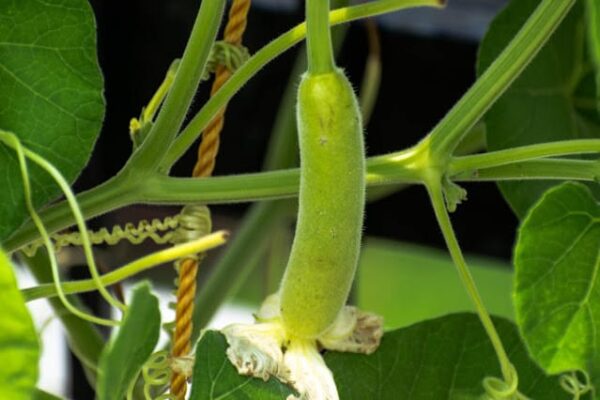Cultivation of Bottle Gourd: It is a fantastic source of vitamins, minerals, and fiber, and is well noted for its cooling and moisturizing effects.
Bottle gourd (Lagenaria siceraria ) belongs to the Cucurbitaceae family. It is an important crop in India. The plant tends to trail. Vegetables include the green stage fruit and stemmed leaves. The fruits in the green stage and the leaves with stems are used as vegetables. A good source of fiber-free carbohydrates is fruit pulp.
The hard shell of the fruit is used for different purposes. used by the tribal community as tools and to make musical instruments.
Bottle gourd originated in Africa. It has spread from Africa to other warm countries.
Common Names of Bottle Gourds:
- Abu (Sanskrit)
- lauki or ghia (Hindi)
- dudhi or tumbadi (Gujarati)
- sorakkai (Tamil)
- chorakkaurdu (Malayalam)
- and ghiya (Urdu)
Nutritive Value of Bottle Gourds:
The nutritional value of a 100-gram portion of bottle gourd is as follows:
| Serving Size: 100 g | %DV | |
| Calories | 15 kcal | |
| Total Carbohydrate | 3.7 g | 1% |
| Dietary Fiber | 1.2 g | 4.00% |
| Sugar | 0 | 0% |
| Protein | 06 g | 1% |
| Cholesterol | 0 | 0% |
| Saturated fat | 0 | 0% |
| Sodium | 2 mg | 0% |
| Potassium | 170 mg | 3% |
| Iron | 1% | |
| Calcium | 2% | |
| Vitamin D | 0% | |
| Cobalamin | 0% | |
| *Percent Daily Values are based on a 2,000-calorie diet. Your daily values may be higher or lower depending on your calorie needs. | ||
Climate Required for Bottle Gourd Cultivation;
A hot and moist climate is favorable for its cultivation. It cannot withstand frost. The plant can tolerate low temperatures, but under extremely cold conditions, its growth is retarded, and frost may kill the bottle gourd plant.
Soil & its preparation for Bottle Gourd Cultivation;
Bottle gourds can be grown in any type of soil. But sandy loam soils are best suited for its cultivation. The suitable pH range for this crop lies between 6 and 7, but some varieties may tolerate alkaline conditions up to 8. The land should be prepared thoroughly by five to six ploughings.
| Variety | Developed by | Characteristics |
| Arka Bahar | IIHR Banglore | Fruits are straight without crookneck and medium-sized, each weighing 1.0 kg at the marketable stage; the fruit is light green and shining and yields 40-50 t/ha. |
| Pusa Naveen | IARI, New Delhi | Fruits are cylindrical, straight, and free from crooked necks. The average weight of 550 g. |
| Pusa Summer- Prolific Long (PSPL) | IARI, New Delhi | Long fruits having a length of 40-50 cm |
| Pusa Summer -Prolific Round (PSPR) | IARI, New Delhi | Round fruits have a diameter of 15-18 cm. |
| Pusa Sandesh | IARI, New Delhi | Round green medium-sized fruits weighing 600 g. Early variety is ready for picking in 55-60 days. Yield 29-32 t/ha. |
| Pusa Meghdoot | IARI, New Delhi | F1 hybrid between PSPL and Sel.2 Fruits long and light green. |
| Pusa Manjari | IARI, New Delhi | F1 hybrid between PSPR and Sel.11. Fruits round and light green, round and light green. |
| Pusa Hybrid 3 | IARI, New Delhi | F1 hybrid having green and slightly, club-shaped fruits without neck. Yield 42.5 t/ha. |
| Narendra Rashmi | NDAU&T, Faizabad, UP. | Moderately tolerant to pumpkin beetle, powdery mildew, and downy mildew. Fruits are bottle-shaped, having shallow necks, average weight of 1.0 kg. Yield 30 t/ha. |
| Pusa Komal | PAU, Ludhiyana | Fruits are medium-sized with an oblong shape and light green skin. Tolerant to CMV, early harvest (70DAS), potential yield 40 t/ha. |
| Punjab Round | PAU | Fruits are round, light green, and shiny. Yield 15.5 t/ha. |
| Kalyanpur Long Green | CSAUA&T,Kanpur | Fruits are long with tapering with a somewhat pointed blossom end, yield 30 t/ha in 120 days. |
| Azad Nutan | NDAU, Faizabad | Early variety with long-necked, free fruits weighing 1.5 kg. |
| Samrat | MPAU, Rahuri | Samrat Fruits are cylindrical without crookneck, greenish-white, 30-40 cm long, weighing 700-800 g, and yield 43 t/ha. |
| Pant Sankar Lauki – 1 | GBPUA&T,Pantnagar | This F1 hybrid has medium-long fruits. Released by the Central Variety Release Committee (CVRC) in 1999. |
| CO.1 | TNAU, Coimbatore | Pale green-colored and bottle-shaped fruits with a narrow neck and a round bottom. Yield 25-30 t/ha. |
Sowing of seeds of Bottle Gourds;
(a) Time of sowing. The seed is sown from January to the end of February for the summer crop, June to July for the rainy season crop in the plains, and April in the hills.
(b) Seed rate. The seed rate is 1.6 to 2.0 kg per acre.
(c) Method of sowing. The seed is sown by a dibbling method at a spacing of 1.5 metres x 0.75 cm. Generally, three to four seeds are sown in a pit at 2.5 to 3.0 cm. depth.
Manuring in Bottle Gourd;
Bottle Gourd requires about 24 kg of nitrogen, 12 kg of phosphoric acid, and 12 kg of potassium per acre. The recommended application of 400 kg of N.P. & K Mixture (5:10: 10) over a basal application of 4 to 6 tons of F.Y.M. or compost per acre.
